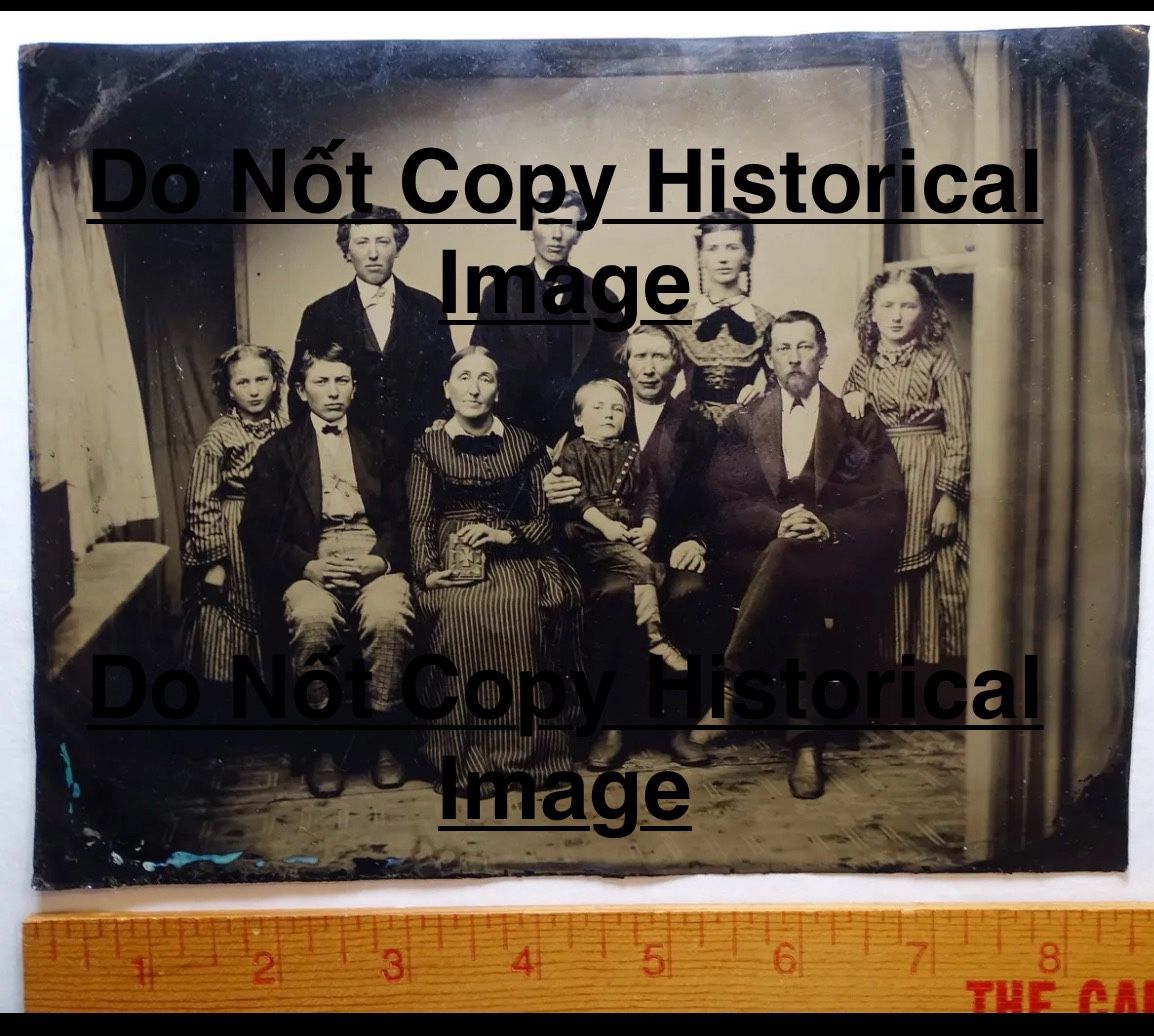RARE Full Plate Tintype Photo - Case Family Auburn NY ca 1860s Recent Discovery
$400
Last updated 11 months ago in Owasco, NY
Condition: Used (normal wear)
Listed in categories: Collectibles & Art - Art
Chat securely on the app
Sold by

SOLD
Additional images
Description
RARE Full Plate Tintype Photo - Case Family Auburn NY ca 1860s Recent Discovery RARE Tintype Photograph Full Plate The Well-known Case Family Auburn, New York ca 1860s For offer, a rare and interesting photo! Fresh from a prominent estate in Upstate NY. Never offered on the market until now. Vintage, Old, Original, Antique, One of a kind. Shows many people in the family, with seated older woman holding photo album. "Chase, Auburn, NY" etched on back. Measures 8 1/2 x 6 1/2 inches. In good to very good condition. I few bends, light creases, minor surface scuffs / scratches - normal for these photos. Please see photos. If you collect 19th century Americana history, women / men portrait, American photography, fashion, etc. this is a treasure you will not see again! Add this to your image or paper / ephemera collection. Perhaps genealogy research importance too. In 1845, Dr. Sylvester Willard joined First Presbyterian Church by letter from Second Presbyterian Church in Chicago, where he had practiced medicine before coming to Auburn. Thus begins the story of First Presbyterian Church and the Case Mansion on the church grounds. Dr. Willard was a well-regarded physician and also an organizer in 1848 of the Oswego Starch Company. He was very wealthy and equally generous. He was a benefactor of First Presbyterian Church and an elder for 38 years (1(contact info removed)). Dr. Willard was a great friend of Rev. Charles Hawley, pastor from 1857 to 1885. Dr. Willard's digest of Dr. Hawley's sermons is a treasure in the church archives. Dr. Willard was married to Jane Case Willard, whose brother, Theodore Pettibone Case, was a benefactor of the church also. His son was Willard Erastus Case, whose son was Theodore Willard Case, the builder of the Case Mansion. Dr. Willard had two daughters. These generous women donated the Willard Chapel to the Auburn Theological Seminary. They died with no heirs other than their cousin Willard Erastus Case. Thus the Willard fortune came into the hands of Theodore Willard (Ted) Case. Ted Case was very inventive and devised a method of putting sound on film. Thus he is credited with inventing "talking pictures." His work was done in a laboratory behind his home, the former Willard Mansion, now the Cayuga Museum. In 1931, having sold the sound on film technology to Fox, Ted Case built the Case Mansion. The MacDougall and Boyd mansions were demolished to make way for the new house, which is very large, with 65 rooms. Over time Ted Case's fortunes waned, and he gave the Willard Mansion to the city in 1936, and the Case Mansion to the city in 1938. In 1931, having sold the sound on film technology to Fox, Ted Case built the Case Mansion. The MacDougall and Boyd mansions were demolished to make way for the new house, which is very large, with 65 rooms. Over time Ted Case's fortunes waned, and he gave the Willard Mansion to the city in 1936, and the Case Mansion to the city in 1938. From 1938 to 1946 the Case Mansion was used for various purposes including a National Youth Administration center, housing women who lived and worked in the mansion, making sheets, pillowcases, and towels for wartime supply. In 1946 the Carmelite Fathers purchased the home from the city for use as a monastery. In 1972 the Carmelites offered shelter to mentally retarded people there. Afterwards, the Fathers invited a group of volunteers to move in and shelter mentally disabled veterans in the mansion. Accounts from that time show these volunteers sacrificed their own homes and money to do this. The service came to be called Unity House. By 1975 the Carmelites could no longer afford to keep the Case Mansion property. In the meantime, First Presbyterian Church continued its mission and ministry. In 1869 the church had built a massive limestone edifice and gradually acquired land all around, often improving the land because there was a need. Then, in 1969, the city embarked on plans to build an arterial highway. The church would lose much of its land, be landlocked on the north side, and thus severed from some of its property. On April 5, 1973 the organist arrived early for choir practice and began to play. The giant steeple collapsed on the organ, but the organist was thrown aside and walked out of the church. The church was destroyed by the collapse, and the congregation determined the church had to be demolished and the site sold. The search began for a new site. The Carmelite Fathers offered land next to the Case Mansion, and there the new First Presbyterian Church was built in 1975. The Carmelites' crisis deepened, and the volunteers feared they would lose their home in the Case Mansion, as well as that of the disabled veterans--and the mission of caring for these men. The volunteers appealed to the First Presbyterian Church to buy the Case Mansion and continue the program. The church did so, thus embarking on yet another enormous mission in a long hist
Take action
Item location map
Map is approximate to keep seller’s location private.